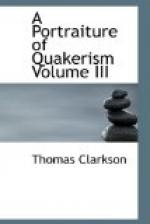[Footnote 30: In process of time, as the bishops became otherwise provided for, the fund was divided into three parts for the other three purposes just mentioned.]
In the eighth century, matters were as I have now represented them. The people had been brought into a notion, that they were to give no less than a tenth of their income to holy uses. Bishops generally at this time, and indeed long previously to this, lived in monasteries. Their clergy lived also with them in these monasteries, and went from thence to preach in the country within the diocese. It must be also noticed, that there were, at this time, other monasteries under abbots or priors, consisting mostly of lay persons, and distinct from those mentioned, and supported by offerings and legacies in the same manner. The latter, however, not having numerous ecclesiastics to support, laid out more of their funds than the former were enabled to do, towards the entertainment of strangers, and towards the maintenance of the poor. Now it must be observed, that, when these two kinds of monasteries existed, the people were at liberty to pay their tithes to either of them as they pleased, and that, having this permission, they generally favoured the latter. To these they not only paid their tithes, but gave their donations by legacy. This preference of the lay abbies to the ecclesiastical arose from a knowledge that the poor, for whose benefit tithes had been originally preached up, would be more materially served. Other circumstances too occurred, which induced the people to continue the same preference. For the bishops in many places began to abuse their trust, as the deacons had done before, by attaching the bequeathed lands to their sees, so that the inferior clergy, and the poor became in a manner dependent upon them for their daily bread. In other places the clergy had seized all to their own use. The people therefore so thoroughly favoured the lay abbies in preference to those of the church, that the former became daily richer, while the, latter did little more than maintain their ground.
This preference, however, which made such a difference in the funds of the ecclesiastical, and of the lay monasteries, was viewed with a jealous eye by the clergy of those times, and measures were at length taken to remove it. In a council under Pope Alexander the third, in the year 1180, it was determined, that the liberty of the people should be restrained with respect to their tithes. They were accordingly




